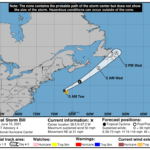ZCZC MIATCDAT2 ALL TTAA00 KNHC DDHHMM Hurricane Larry Discussion Number 12 NWS National Hurricane Center Miami FL AL122021 1100 AM AST Fri Sep 03 2021 Larry continues to have the presentation of a hurricane that is gradually becoming better organized. Its structure this morning consists of well defined spiral banding around a somewhat asymmetric central dense overcast. More recently, a warm spot appears to be forming on both infrared and visible satellite channels which could foreshadow the development of a better-defined eye, as hinted at on an earlier 0934 UTC SSMIS microwave pass. The most recent subjective Dvorak classifications at 1200 UTC were still CI 4.5/77 kt from TAFB and SAB. Interestingly, the objective satellite estimates from ADT and SATCON remain on the lower side, though these seem conservative given the structural improvements seen on recent satellite images. Favoring the subjective estimates, the initial intensity is being maintained at 80 kt for this advisory. Larry continues to move to the west-northwest at 285/14 kt. A prominent mid-level ridge located to the north of the hurricane is expected to continue this heading over the next 24 to 36 hours, though with a gradual decrease in forward speed. As Larry continues to move west-northwest, the ridge axis will gradually re-position to the northeast of the tropical cyclone, providing an avenue for the hurricane to begin gaining more latitude. Starting around 72 hours, a bit more cross-track spread begins to emerge in the track guidance, related to both how much ridging remains directly poleward of Larry, and also the outer-core size of the tropical cyclone itself. For example, the most recent GFS run shifts most of the ridging to the east of Larry and also expands the outer radius of cyclone dramatically, helping to widen the poleward weakness allowing a more northward track by 120 hours. By contrast, the ECMWF maintains a more compact hurricane in the mid-levels, and maintains more mid-level ridging to the north of the cyclone. These differences in the ECMWF allow a bit more of a westward track closer to the Island of Bermuda. For now, the latest NHC track forecast is in between these solutions, though with a slight preference towards the ECMWF, which is also close to the latest HCCA consensus aid forecast. This track forecast is quite similar to the previous forecast. Given the track uncertainty by day 5, it is too soon to determine what impacts Larry may pose to the Island of Bermuda, but interests there should monitor updates in the forecast in the subsequent days. Larry remains embedded in a favorable environment for intensification, with low vertical wind shear under 10 kt and a sufficently moist mid-level environment. However, the hurricane has had difficulty closing off its inner-core structure, which might be preventing more rapid development from taking place. Assuming its inner core becomes better established, Larry is expected to intensity at a decent clip over the next 36-48 hours, and is forecast to become a major hurricane this weekend with a peak intensity of 120 kt by Monday. Afterwards, both the ECMWF-SHIPS guidance and latest HWRF run suggest that westerly vertical wind shear, from an upper-level mid-oceanic trough positioned northwest of Larry, could begin to undercut the favorable upper-level environment of the large tropical cyclone. Thus, some gradual weakening is shown from days 3-5 in the NHC intensity forecast. This latest forecast is quite similar to the previous one and is on the upper-end of the guidance envelope, though still not as high as the most recent COAMPS-TC and experimental HAFS-B runs. This intensity forecast also does not account for possible eyewall replacement cycles, which could cause additional intensity fluctuations that are difficult to predict several days in advance. Significant ocean swells generated by the large wind field of Larry are expected to reach the Lesser Antilles on Sunday, increasing the risk of life-threatening rip currents and high surf conditions on those islands early next week. Large swells are likely to spread to areas surrounding the western Atlantic later in the week as well. FORECAST POSITIONS AND MAX WINDS INIT 03/1500Z 14.8N 40.7W 80 KT 90 MPH 12H 04/0000Z 15.4N 42.8W 90 KT 105 MPH 24H 04/1200Z 16.5N 45.3W 100 KT 115 MPH 36H 05/0000Z 17.6N 47.6W 110 KT 125 MPH 48H 05/1200Z 19.0N 49.8W 115 KT 130 MPH 60H 06/0000Z 20.2N 51.8W 120 KT 140 MPH 72H 06/1200Z 21.4N 53.6W 120 KT 140 MPH 96H 07/1200Z 24.2N 56.9W 115 KT 130 MPH 120H 08/1200Z 27.8N 60.0W 105 KT 120 MPH $$ Forecaster Papin NNNN



